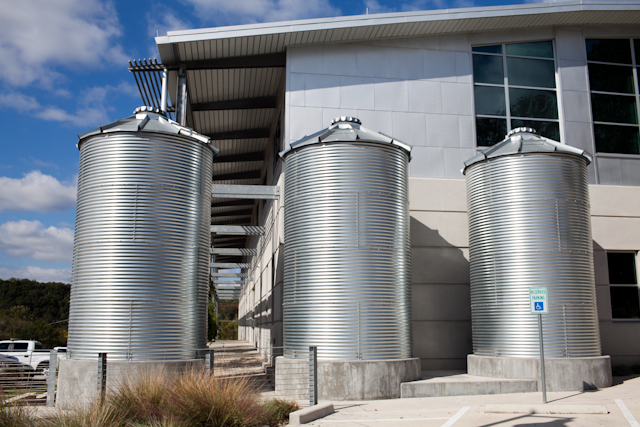Austin Turns to Green Building as Energy Costs Rise

The Lower Colorado River Authority's facility located on Lake Austin Boulevard is looking toward a more green building as costs rise. Photo by Lizzie Chen.
By Carson Lane
For Reporting Texas
AUSTIN — One of the hottest summers on record and the prospect of higher electricity bills are giving a push to the green building movement in Central Texas.
The area had more than 90 days of 100-plus degree temperatures this past summer, and Austin Electric, the city’s power utility, is proposing to increase electric rates for the first time in 17 years. The utility is expanding purchases of renewable wind energy, which is more expensive than conventional electricity.
“Everyone we talk to now wants spray foam insulation, tankless water heaters, more efficient windows, et cetera,” said A.J. Smith, an architect at Forsite Studio, a sustainable design and construction company, “whereas in the past we might only have incorporated a couple of those features.”
Kyle Ashley, co-founder of Austin-based Green Building Energy Services, a sustainable retrofitting and building company, said up to 80 percent of the homes and buildings in Austin do not comply with energy-conservation portions of the building code.
“As buildings make up 40 percent of energy use in Texas — and nearly 70 percent of electricity use — there’s a great opportunity for Austinites to improve the energy efficiency of their buildings,” Ashley said.
Local companies, Ashley said, improve energy efficiency by retrofitting buildings with better ventilation, insulated windows and doors, and better roofing and insulation. Many new buildings have all these conservation measures included in their design.
For commercial buildings, he said, the most common retrofit is roof treatment that improves energy efficiency with better shielding against moisture, air and heat from sunlight. He said he uses a spray foam treatment on roofs.
For residential structures, Green Building Energy has done retrofits on older homes in the Hill Country and downtown Austin. The most frequent update, he said, is more ventilation in the attic.
“They often don’t have enough air intake into the attic,” Ashley said. “The air becomes stale and heats up like a conduction oven.”
Ashley said that while every building is different, utility bills for retrofitted buildings are reduced between 15 and 30 percent. Aside from the financial impact, the amount of energy that can be conserved is around 20 percent during heating and cooling months.
Initial costs depend on the technologies involved in a retrofit or new building, said Smith of Forsite Studio.
“With federal and local incentives you can see a return on investment in about seven years,” he said.
April Clark, a partner at Clark Richardson Architects, said builders are incorporating environmental considerations into plans for new structures.
“If you orient a building in Austin to have a majority of east- or west-facing glass, the space will heat up dramatically more than a building with a majority of south- and north-facing glass, where direct solar gain is easily controlled. The higher the heat gain in the climate, the more you will have to run you AC, and the more expensive your bill will be.”
Clark is an advocate for natural light in buildings as well as the directions they face.
“If you can get natural daylighting into every space, it cuts the need to always have lights on,” she said. “Having natural light, for instance, is more comfortable and also it cuts down on the need for electric light. … Natural light, good ventilation and building with materials that do not emit harmful chemicals and toxins are all key.”